To the Hilton
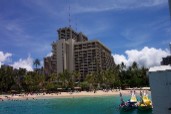 SWMBO and I
went on a short vacation last week. From Monday through Friday
morning we were at the Hilton Hawaiian Village
Ali'i Tower. Ali'i Tower, one of several hotels on the
property, is on the beach facing Diamond Head. The Tower features
it's own pool/sun deck, whirlpool, and business center. Each room
includes a direct telephone line and dedicated fax line. The fax
line is hooked up to an HP all-in-one fax/scanner/printer.
Unfortunately, Internet access is either through your laptop
hooked into the phone line or via their TV. Not exactly business
friendly but at least there are ports on the side of the two
phones in the bedroom (the phone in the bathroom does not have a
port).
SWMBO and I
went on a short vacation last week. From Monday through Friday
morning we were at the Hilton Hawaiian Village
Ali'i Tower. Ali'i Tower, one of several hotels on the
property, is on the beach facing Diamond Head. The Tower features
it's own pool/sun deck, whirlpool, and business center. Each room
includes a direct telephone line and dedicated fax line. The fax
line is hooked up to an HP all-in-one fax/scanner/printer.
Unfortunately, Internet access is either through your laptop
hooked into the phone line or via their TV. Not exactly business
friendly but at least there are ports on the side of the two
phones in the bedroom (the phone in the bathroom does not have a
port).
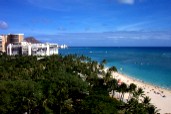 Diamond Head, or Leahi as it is known in
Hawai'ian, can barely be seen in the distance. During the
building boom of the 1960s to 70s, the state bird was
(facetiously) the construction crane - being that so many hotels
were built to accommodate the increased number of visitors with
the coming of cheaper jet aircraft service. Fortunately, there is
still some open areas - including this park in front of the Hale
Koa Hotel (for the military) next door to the Hilton. Also nice
is the wide white-sand beach fronting this part of the village.
This is in contrast to those hotels in the heart of Waikiki which
are almost right up to the water's edge - leaving precious little
beach to walk on.
Diamond Head, or Leahi as it is known in
Hawai'ian, can barely be seen in the distance. During the
building boom of the 1960s to 70s, the state bird was
(facetiously) the construction crane - being that so many hotels
were built to accommodate the increased number of visitors with
the coming of cheaper jet aircraft service. Fortunately, there is
still some open areas - including this park in front of the Hale
Koa Hotel (for the military) next door to the Hilton. Also nice
is the wide white-sand beach fronting this part of the village.
This is in contrast to those hotels in the heart of Waikiki which
are almost right up to the water's edge - leaving precious little
beach to walk on.
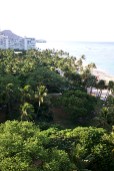 This is
another shot of the park and gives a better sense of depth. With
hotels being built so close to each other it is rare in Waikiki
to have open space. It is one of the reasons we chose this hotel
over some of the more luxurious ones. The park itself has shaded
picnic benches and barbecues so anyone can spend a nice day at
the beach without being run over by thousands of pink skinned
visitors. Speaking of the beach, we were unfortunately there
during the time of the month in which the box jelly fish come in
(see one account of what happens each month here).
So we were unable/unwilling to set foot in the water, at least,
not until later in the week when the warning signs were taken
down. By that time, we were at our next hotel, but I will save
that for tomorrow's post.
This is
another shot of the park and gives a better sense of depth. With
hotels being built so close to each other it is rare in Waikiki
to have open space. It is one of the reasons we chose this hotel
over some of the more luxurious ones. The park itself has shaded
picnic benches and barbecues so anyone can spend a nice day at
the beach without being run over by thousands of pink skinned
visitors. Speaking of the beach, we were unfortunately there
during the time of the month in which the box jelly fish come in
(see one account of what happens each month here).
So we were unable/unwilling to set foot in the water, at least,
not until later in the week when the warning signs were taken
down. By that time, we were at our next hotel, but I will save
that for tomorrow's post.
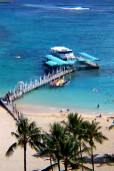 One of the things we did while at the Hilton
was take a submarine ride. The picture on the left is of the good
ship "Discovery" as it docked in front of our hotel (as seen from
our room on the 13th floor). The Discovery takes you out about a
mile off Waikiki to one of three
Atlantis submarines. The larger sub holds 64 and the smaller
two, one of which we were on, holds 48. The Discovery pulls up
next to the subs and transfers the passengers over in the open
ocean. Needless to say, if there are big waves or high winds,
this is not a Good Thing. Even on the day we went, with waves in
the one to four foot range, it is not something you want to do
unless you've taken sea sickness pills and you are sure of foot.
In either case, once on board and the sub and has reached at
least 20-feet below the surface things settle down nicely (at one
point you reach about 120-ft. down).
One of the things we did while at the Hilton
was take a submarine ride. The picture on the left is of the good
ship "Discovery" as it docked in front of our hotel (as seen from
our room on the 13th floor). The Discovery takes you out about a
mile off Waikiki to one of three
Atlantis submarines. The larger sub holds 64 and the smaller
two, one of which we were on, holds 48. The Discovery pulls up
next to the subs and transfers the passengers over in the open
ocean. Needless to say, if there are big waves or high winds,
this is not a Good Thing. Even on the day we went, with waves in
the one to four foot range, it is not something you want to do
unless you've taken sea sickness pills and you are sure of foot.
In either case, once on board and the sub and has reached at
least 20-feet below the surface things settle down nicely (at one
point you reach about 120-ft. down).
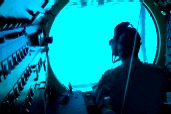 This
is looking forward, towards the captain, and out the huge 4-inch
thick plexi-glass dome. There are ports along the side of the sub
for each passenger to look out but since I was sitting directly
behind the captain I spent as much time looking forward as to the
side. Due to the last hurricane that came near the islands (about
10 years ago), the near-shore bottom was pretty much scraped
clean of marine growth/coral. As a result, Atlantis spent a fair
amount of time and money creating artificial reefs so as to
attract fish and coral growth.
This
is looking forward, towards the captain, and out the huge 4-inch
thick plexi-glass dome. There are ports along the side of the sub
for each passenger to look out but since I was sitting directly
behind the captain I spent as much time looking forward as to the
side. Due to the last hurricane that came near the islands (about
10 years ago), the near-shore bottom was pretty much scraped
clean of marine growth/coral. As a result, Atlantis spent a fair
amount of time and money creating artificial reefs so as to
attract fish and coral growth.
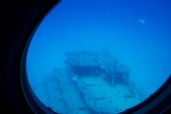 The first
of the reefs is called "Pyramids" because of the shape of the
concrete blocks. This is a Japanese design that creates a series
of floors and ceilings that the smaller fish can hide in. Hiding
is something smaller fish need to do to keep from getting eaten
by larger predatory fish. Hence, if the bottom is clean of hiding
spaces, you won't find many fish hanging around. Conversely,
creating a multitude of spaces for small fish will result in fish
congregating there. In addition, coral and other marine organisms
will soon build their homes, thus creating even more places for
small fish. And where there are small fish, the larger fish are
soon to come. And where there are sea life to look at, people
will follow.
The first
of the reefs is called "Pyramids" because of the shape of the
concrete blocks. This is a Japanese design that creates a series
of floors and ceilings that the smaller fish can hide in. Hiding
is something smaller fish need to do to keep from getting eaten
by larger predatory fish. Hence, if the bottom is clean of hiding
spaces, you won't find many fish hanging around. Conversely,
creating a multitude of spaces for small fish will result in fish
congregating there. In addition, coral and other marine organisms
will soon build their homes, thus creating even more places for
small fish. And where there are small fish, the larger fish are
soon to come. And where there are sea life to look at, people
will follow.
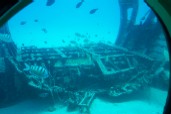 This
next artificial reef is a section of an airplane. Pictured is
part of the fuselage but the entire plane was sunk. Over time,
and with strong currents and storms, the plane has broken apart
and is scattered in several places. The plane was from an
inter-island airline that went bankrupt. Atlantis bought the
plane, and after removing toxic materials, sank the plane to
create a home for fish. The plane hasn't been underwater for that
long so you don't see much marine growth, however, the fish do
seem to like it.
This
next artificial reef is a section of an airplane. Pictured is
part of the fuselage but the entire plane was sunk. Over time,
and with strong currents and storms, the plane has broken apart
and is scattered in several places. The plane was from an
inter-island airline that went bankrupt. Atlantis bought the
plane, and after removing toxic materials, sank the plane to
create a home for fish. The plane hasn't been underwater for that
long so you don't see much marine growth, however, the fish do
seem to like it.
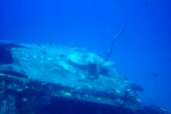 This third reef is an old fishing boat that was no longer
being used. As with the plane, it needed to be cleansed of all
hazardous materials, including its fuel oil and reportedly took
much time and effort to do so. The object in the center is a
large turtle that has made the ship its temporary home. Be aware
that the Hawai'ian
green sea turtle is a protected species under state and
federal law. Unfortunately, this has not stopped people from
hunting these creatures almost to extinction. You can also see
the beginning of coral heads, which is an indication that the
ship has been there for at least 10 years.
This third reef is an old fishing boat that was no longer
being used. As with the plane, it needed to be cleansed of all
hazardous materials, including its fuel oil and reportedly took
much time and effort to do so. The object in the center is a
large turtle that has made the ship its temporary home. Be aware
that the Hawai'ian
green sea turtle is a protected species under state and
federal law. Unfortunately, this has not stopped people from
hunting these creatures almost to extinction. You can also see
the beginning of coral heads, which is an indication that the
ship has been there for at least 10 years.
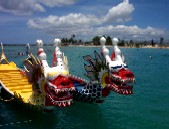 I
thought this was an interesting shot of a couple of
dragon boats tied up along side the dock. We saw tourists
going out in them but decided we would rather have an engine push
us along rather than have to paddle this heavy thing! For those
interested, you can follow the link above to the history of
dragon boat racing and how it has become an international
festival. As with many ancient rites, it is based on superstition
but has become secularized into what it is today. In any case,
the boats are colorful and are something to see when they are
moving along at a fast clip. We've seen the races at Ala Moana
park in which a rider sits on the head of the dragon and reaches
for the flag at the finish line. Even if you cross the finish
line first, you must still have the flag grasped in your hands.
So it is possible for a slower boat to win if the flag-person is
not good with their hands.
I
thought this was an interesting shot of a couple of
dragon boats tied up along side the dock. We saw tourists
going out in them but decided we would rather have an engine push
us along rather than have to paddle this heavy thing! For those
interested, you can follow the link above to the history of
dragon boat racing and how it has become an international
festival. As with many ancient rites, it is based on superstition
but has become secularized into what it is today. In any case,
the boats are colorful and are something to see when they are
moving along at a fast clip. We've seen the races at Ala Moana
park in which a rider sits on the head of the dragon and reaches
for the flag at the finish line. Even if you cross the finish
line first, you must still have the flag grasped in your hands.
So it is possible for a slower boat to win if the flag-person is
not good with their hands.
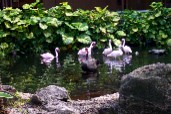 From
dragons to birds. In this case, some flamingoes and a lone black
swan. Long-time readers of this column will remember my run-in
with a black swan last year on Maui. It seems the swans are
rather territorial and will charge towards you if they think you
are encroaching on their turf (or water, as the case may be).
However, this particular one seemed tamer and would let people
touch it. Being that as it may, the village grounds had water
fowl of various kinds populating the many artificial lagoons and
rivers. But, they are not pets. Hence, do not think you can treat
them as such unless you want to be called "Lefty."
From
dragons to birds. In this case, some flamingoes and a lone black
swan. Long-time readers of this column will remember my run-in
with a black swan last year on Maui. It seems the swans are
rather territorial and will charge towards you if they think you
are encroaching on their turf (or water, as the case may be).
However, this particular one seemed tamer and would let people
touch it. Being that as it may, the village grounds had water
fowl of various kinds populating the many artificial lagoons and
rivers. But, they are not pets. Hence, do not think you can treat
them as such unless you want to be called "Lefty."
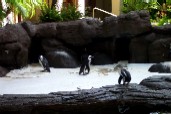 Most people think of penguins in cold
climates. But from what I understand, there are more warm weather
species than cold. I don't know the particular species these are
from but they have a little habitat on the grounds of the village
and draw quite a crowd during the twice-daily feeding times
(8:00am and 3:00pm). It is during these times that the penguins
are most active so if you want to see them doing something other
than sleeping, those two times are when you want to be there. It
is kind of cute how then line up during feeding and wait their
turns to get their daily fish. I didn't have my camera with me
but they all line up and are fed one-by-one. Although, there
was one penguin that got tired of waiting and cut in to
the front of the line. But as far as I could see, there was no
retaliation by any of the others waiting. [G]
Most people think of penguins in cold
climates. But from what I understand, there are more warm weather
species than cold. I don't know the particular species these are
from but they have a little habitat on the grounds of the village
and draw quite a crowd during the twice-daily feeding times
(8:00am and 3:00pm). It is during these times that the penguins
are most active so if you want to see them doing something other
than sleeping, those two times are when you want to be there. It
is kind of cute how then line up during feeding and wait their
turns to get their daily fish. I didn't have my camera with me
but they all line up and are fed one-by-one. Although, there
was one penguin that got tired of waiting and cut in to
the front of the line. But as far as I could see, there was no
retaliation by any of the others waiting. [G]
I'm out of time and this will have to be posted later than normal because I have to get to work. Tomorrow I will have a short post on the hotel we went to on Friday.
Aloha!